Project on Malaysian Consumer Purchase Behavior in e-Commerce Analysis
VerifiedAdded on 2021/02/19
|38
|17489
|19
Project
AI Summary
This project investigates Malaysian consumer purchase behavior within the e-commerce landscape. It examines the shift from traditional retail to online shopping, highlighting the opportunities and challenges presented by platforms like Lazada and Shopee. The research explores the factors influencing consumer decisions, including psychological, social, cultural, quality, and price considerations. The project includes an introduction with background information, research aims, objectives, questions, and hypotheses. A literature review analyzes online consumer purchasing behavior, the characteristics of Malaysian online shoppers, and the online shopping process. The methodology section details the research design, validity, reliability, and questionnaire design. Findings are presented through thematic analysis and datasets. The analysis and discussion section examines the data collected from the questionnaires and provides suggestions for Malaysian online shops in the marketing process. The project concludes with recommendations, limitations, and suggestions for future research, aiming to provide insights into the dynamics of e-commerce in Malaysia.

Research and Consultancy
Project
Project
Paraphrase This Document
Need a fresh take? Get an instant paraphrase of this document with our AI Paraphraser
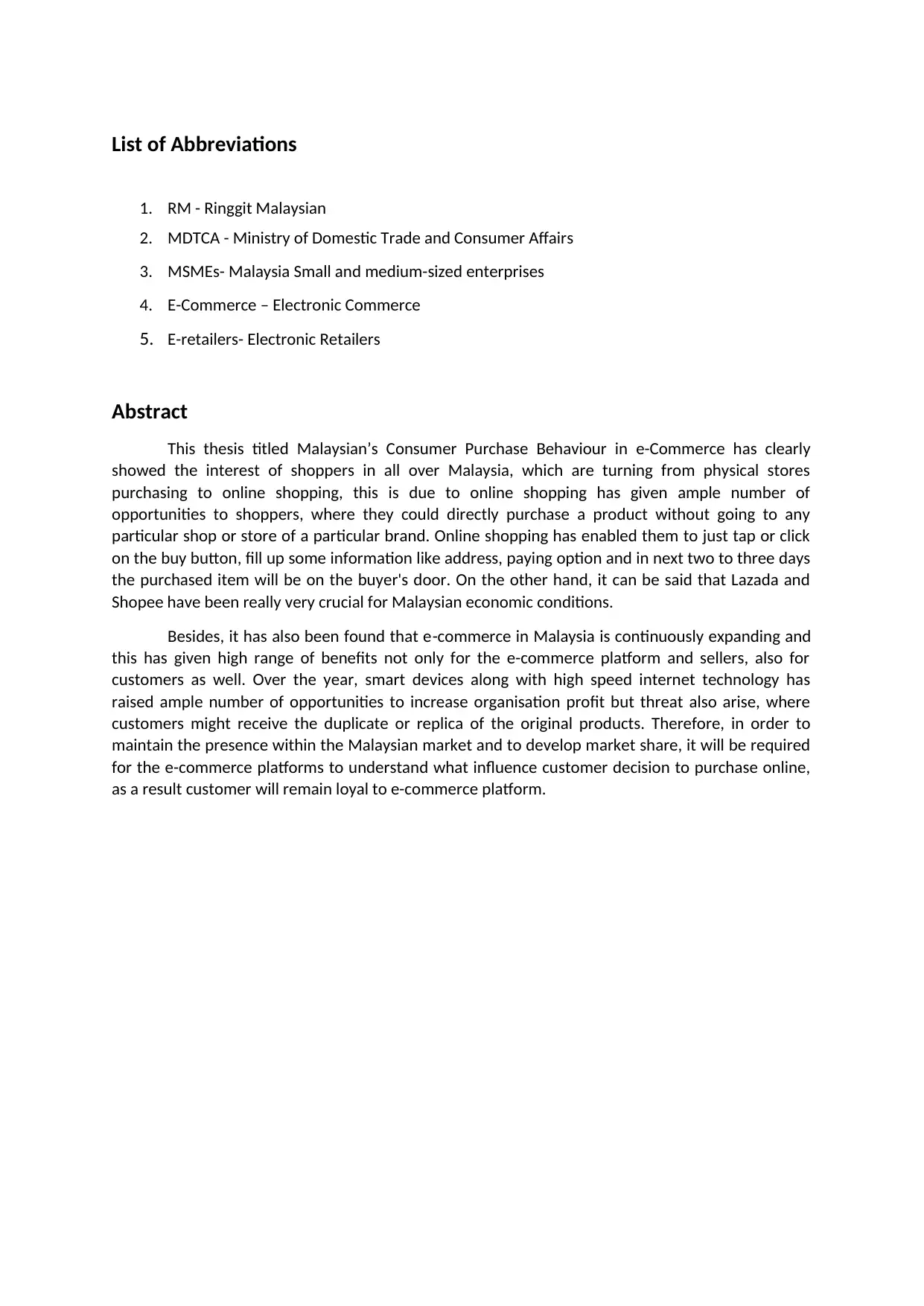
List of Abbreviations
1. RM - Ringgit Malaysian
2. MDTCA - Ministry of Domestic Trade and Consumer Affairs
3. MSMEs- Malaysia Small and medium-sized enterprises
4. E-Commerce – Electronic Commerce
5. E-retailers- Electronic Retailers
Abstract
This thesis titled Malaysian’s Consumer Purchase Behaviour in e-Commerce has clearly
showed the interest of shoppers in all over Malaysia, which are turning from physical stores
purchasing to online shopping, this is due to online shopping has given ample number of
opportunities to shoppers, where they could directly purchase a product without going to any
particular shop or store of a particular brand. Online shopping has enabled them to just tap or click
on the buy button, fill up some information like address, paying option and in next two to three days
the purchased item will be on the buyer's door. On the other hand, it can be said that Lazada and
Shopee have been really very crucial for Malaysian economic conditions.
Besides, it has also been found that e-commerce in Malaysia is continuously expanding and
this has given high range of benefits not only for the e-commerce platform and sellers, also for
customers as well. Over the year, smart devices along with high speed internet technology has
raised ample number of opportunities to increase organisation profit but threat also arise, where
customers might receive the duplicate or replica of the original products. Therefore, in order to
maintain the presence within the Malaysian market and to develop market share, it will be required
for the e-commerce platforms to understand what influence customer decision to purchase online,
as a result customer will remain loyal to e-commerce platform.
1. RM - Ringgit Malaysian
2. MDTCA - Ministry of Domestic Trade and Consumer Affairs
3. MSMEs- Malaysia Small and medium-sized enterprises
4. E-Commerce – Electronic Commerce
5. E-retailers- Electronic Retailers
Abstract
This thesis titled Malaysian’s Consumer Purchase Behaviour in e-Commerce has clearly
showed the interest of shoppers in all over Malaysia, which are turning from physical stores
purchasing to online shopping, this is due to online shopping has given ample number of
opportunities to shoppers, where they could directly purchase a product without going to any
particular shop or store of a particular brand. Online shopping has enabled them to just tap or click
on the buy button, fill up some information like address, paying option and in next two to three days
the purchased item will be on the buyer's door. On the other hand, it can be said that Lazada and
Shopee have been really very crucial for Malaysian economic conditions.
Besides, it has also been found that e-commerce in Malaysia is continuously expanding and
this has given high range of benefits not only for the e-commerce platform and sellers, also for
customers as well. Over the year, smart devices along with high speed internet technology has
raised ample number of opportunities to increase organisation profit but threat also arise, where
customers might receive the duplicate or replica of the original products. Therefore, in order to
maintain the presence within the Malaysian market and to develop market share, it will be required
for the e-commerce platforms to understand what influence customer decision to purchase online,
as a result customer will remain loyal to e-commerce platform.
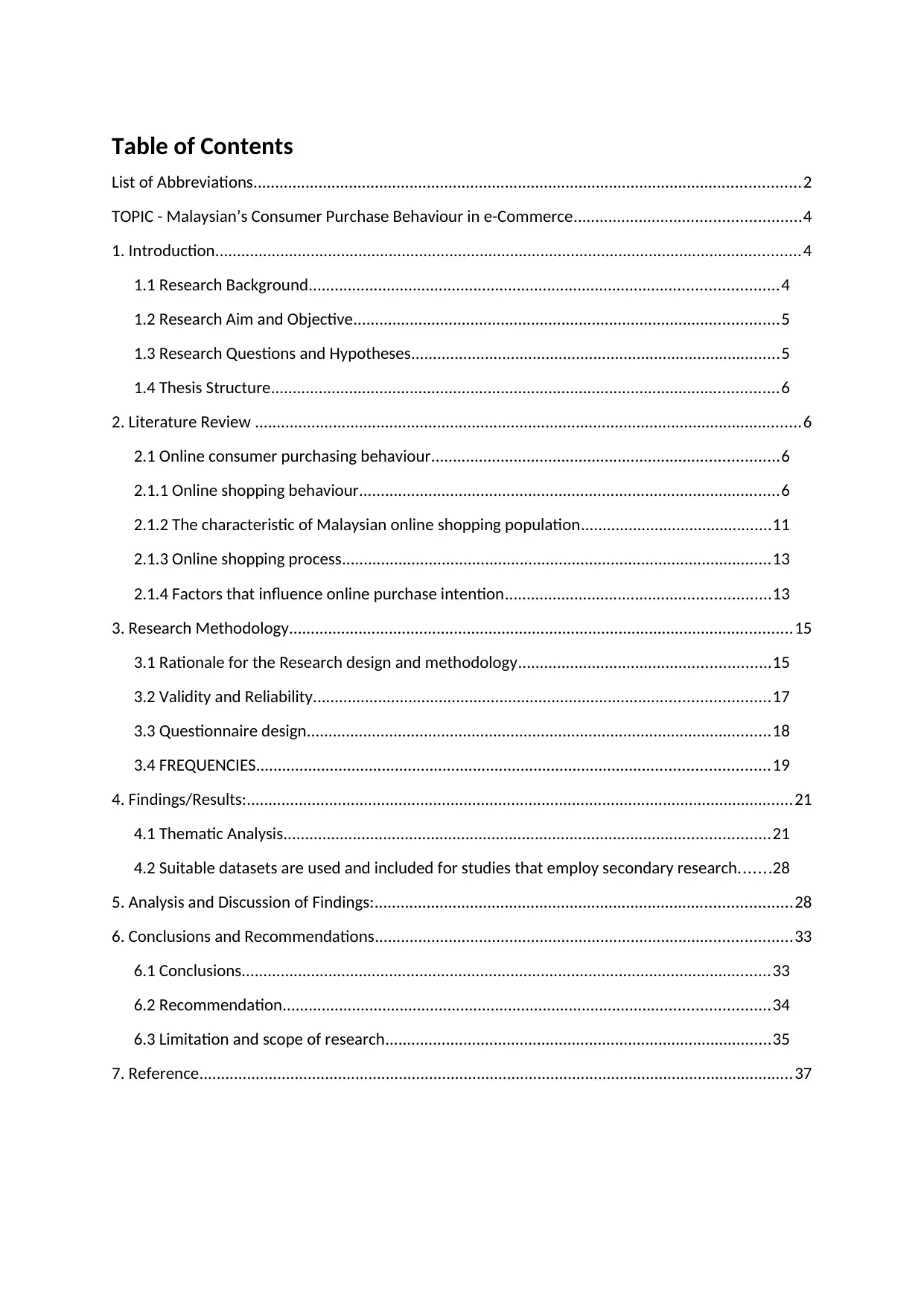
Table of Contents
List of Abbreviations..............................................................................................................................2
TOPIC - Malaysian’s Consumer Purchase Behaviour in e-Commerce....................................................4
1. Introduction.......................................................................................................................................4
1.1 Research Background............................................................................................................4
1.2 Research Aim and Objective..................................................................................................5
1.3 Research Questions and Hypotheses.....................................................................................5
1.4 Thesis Structure.....................................................................................................................6
2. Literature Review ..............................................................................................................................6
2.1 Online consumer purchasing behaviour................................................................................6
2.1.1 Online shopping behaviour.................................................................................................6
2.1.2 The characteristic of Malaysian online shopping population............................................11
2.1.3 Online shopping process...................................................................................................13
2.1.4 Factors that influence online purchase intention.............................................................13
3. Research Methodology....................................................................................................................15
3.1 Rationale for the Research design and methodology..........................................................15
3.2 Validity and Reliability.........................................................................................................17
3.3 Questionnaire design...........................................................................................................18
3.4 FREQUENCIES......................................................................................................................19
4. Findings/Results:..............................................................................................................................21
4.1 Thematic Analysis................................................................................................................21
4.2 Suitable datasets are used and included for studies that employ secondary research.......28
5. Analysis and Discussion of Findings:................................................................................................28
6. Conclusions and Recommendations................................................................................................33
6.1 Conclusions..........................................................................................................................33
6.2 Recommendation................................................................................................................34
6.3 Limitation and scope of research.........................................................................................35
7. Reference.........................................................................................................................................37
List of Abbreviations..............................................................................................................................2
TOPIC - Malaysian’s Consumer Purchase Behaviour in e-Commerce....................................................4
1. Introduction.......................................................................................................................................4
1.1 Research Background............................................................................................................4
1.2 Research Aim and Objective..................................................................................................5
1.3 Research Questions and Hypotheses.....................................................................................5
1.4 Thesis Structure.....................................................................................................................6
2. Literature Review ..............................................................................................................................6
2.1 Online consumer purchasing behaviour................................................................................6
2.1.1 Online shopping behaviour.................................................................................................6
2.1.2 The characteristic of Malaysian online shopping population............................................11
2.1.3 Online shopping process...................................................................................................13
2.1.4 Factors that influence online purchase intention.............................................................13
3. Research Methodology....................................................................................................................15
3.1 Rationale for the Research design and methodology..........................................................15
3.2 Validity and Reliability.........................................................................................................17
3.3 Questionnaire design...........................................................................................................18
3.4 FREQUENCIES......................................................................................................................19
4. Findings/Results:..............................................................................................................................21
4.1 Thematic Analysis................................................................................................................21
4.2 Suitable datasets are used and included for studies that employ secondary research.......28
5. Analysis and Discussion of Findings:................................................................................................28
6. Conclusions and Recommendations................................................................................................33
6.1 Conclusions..........................................................................................................................33
6.2 Recommendation................................................................................................................34
6.3 Limitation and scope of research.........................................................................................35
7. Reference.........................................................................................................................................37
⊘ This is a preview!⊘
Do you want full access?
Subscribe today to unlock all pages.

Trusted by 1+ million students worldwide
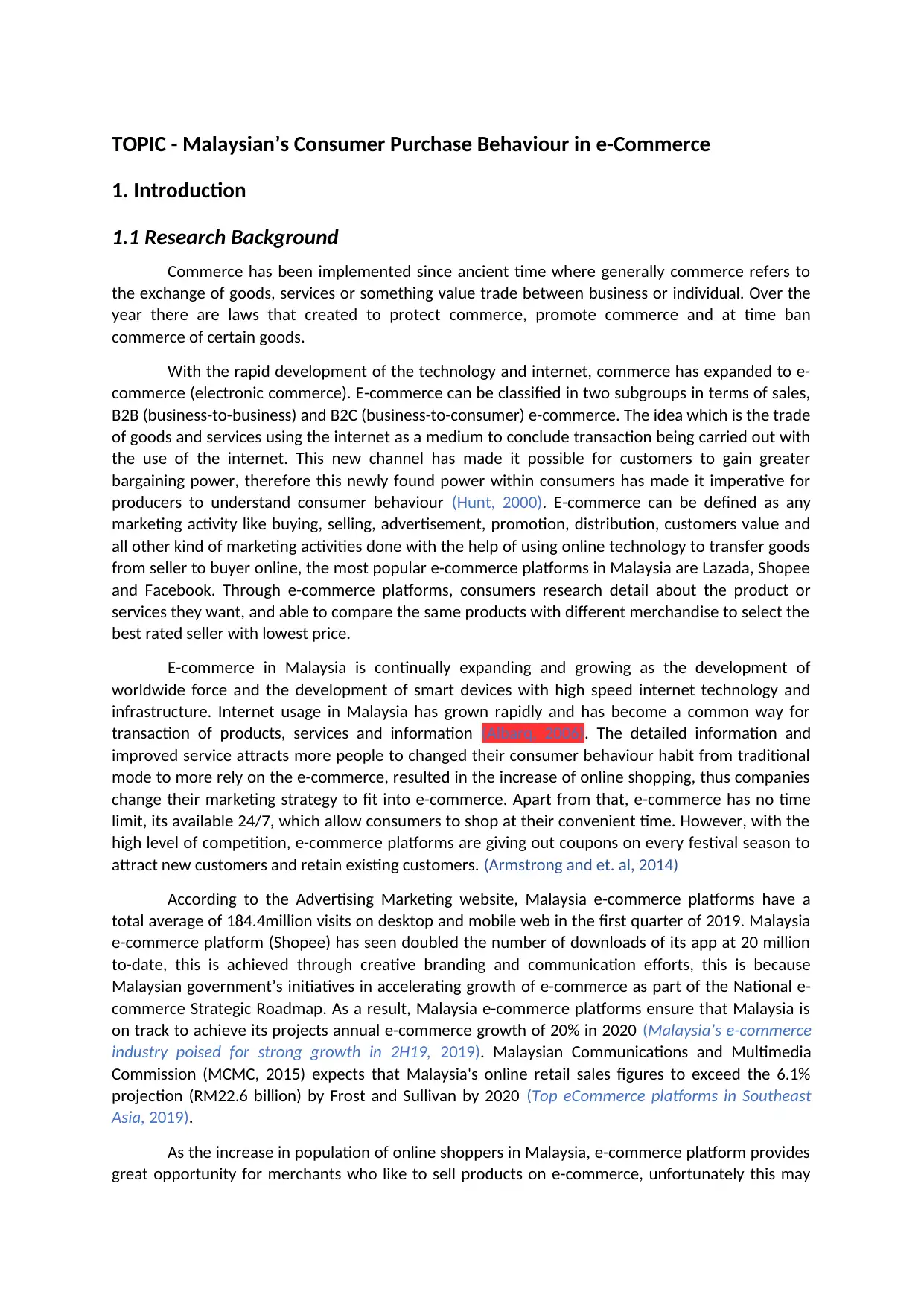
TOPIC - Malaysian’s Consumer Purchase Behaviour in e-Commerce
1. Introduction
1.1 Research Background
Commerce has been implemented since ancient time where generally commerce refers to
the exchange of goods, services or something value trade between business or individual. Over the
year there are laws that created to protect commerce, promote commerce and at time ban
commerce of certain goods.
With the rapid development of the technology and internet, commerce has expanded to e-
commerce (electronic commerce). E-commerce can be classified in two subgroups in terms of sales,
B2B (business-to-business) and B2C (business-to-consumer) e-commerce. The idea which is the trade
of goods and services using the internet as a medium to conclude transaction being carried out with
the use of the internet. This new channel has made it possible for customers to gain greater
bargaining power, therefore this newly found power within consumers has made it imperative for
producers to understand consumer behaviour (Hunt, 2000). E-commerce can be defined as any
marketing activity like buying, selling, advertisement, promotion, distribution, customers value and
all other kind of marketing activities done with the help of using online technology to transfer goods
from seller to buyer online, the most popular e-commerce platforms in Malaysia are Lazada, Shopee
and Facebook. Through e-commerce platforms, consumers research detail about the product or
services they want, and able to compare the same products with different merchandise to select the
best rated seller with lowest price.
E-commerce in Malaysia is continually expanding and growing as the development of
worldwide force and the development of smart devices with high speed internet technology and
infrastructure. Internet usage in Malaysia has grown rapidly and has become a common way for
transaction of products, services and information (Albarq, 2006). The detailed information and
improved service attracts more people to changed their consumer behaviour habit from traditional
mode to more rely on the e-commerce, resulted in the increase of online shopping, thus companies
change their marketing strategy to fit into e-commerce. Apart from that, e-commerce has no time
limit, its available 24/7, which allow consumers to shop at their convenient time. However, with the
high level of competition, e-commerce platforms are giving out coupons on every festival season to
attract new customers and retain existing customers. (Armstrong and et. al, 2014)
According to the Advertising Marketing website, Malaysia e-commerce platforms have a
total average of 184.4million visits on desktop and mobile web in the first quarter of 2019. Malaysia
e-commerce platform (Shopee) has seen doubled the number of downloads of its app at 20 million
to-date, this is achieved through creative branding and communication efforts, this is because
Malaysian government’s initiatives in accelerating growth of e-commerce as part of the National e-
commerce Strategic Roadmap. As a result, Malaysia e-commerce platforms ensure that Malaysia is
on track to achieve its projects annual e-commerce growth of 20% in 2020 (Malaysia’s e-commerce
industry poised for strong growth in 2H19, 2019). Malaysian Communications and Multimedia
Commission (MCMC, 2015) expects that Malaysia's online retail sales figures to exceed the 6.1%
projection (RM22.6 billion) by Frost and Sullivan by 2020 (Top eCommerce platforms in Southeast
Asia, 2019).
As the increase in population of online shoppers in Malaysia, e-commerce platform provides
great opportunity for merchants who like to sell products on e-commerce, unfortunately this may
1. Introduction
1.1 Research Background
Commerce has been implemented since ancient time where generally commerce refers to
the exchange of goods, services or something value trade between business or individual. Over the
year there are laws that created to protect commerce, promote commerce and at time ban
commerce of certain goods.
With the rapid development of the technology and internet, commerce has expanded to e-
commerce (electronic commerce). E-commerce can be classified in two subgroups in terms of sales,
B2B (business-to-business) and B2C (business-to-consumer) e-commerce. The idea which is the trade
of goods and services using the internet as a medium to conclude transaction being carried out with
the use of the internet. This new channel has made it possible for customers to gain greater
bargaining power, therefore this newly found power within consumers has made it imperative for
producers to understand consumer behaviour (Hunt, 2000). E-commerce can be defined as any
marketing activity like buying, selling, advertisement, promotion, distribution, customers value and
all other kind of marketing activities done with the help of using online technology to transfer goods
from seller to buyer online, the most popular e-commerce platforms in Malaysia are Lazada, Shopee
and Facebook. Through e-commerce platforms, consumers research detail about the product or
services they want, and able to compare the same products with different merchandise to select the
best rated seller with lowest price.
E-commerce in Malaysia is continually expanding and growing as the development of
worldwide force and the development of smart devices with high speed internet technology and
infrastructure. Internet usage in Malaysia has grown rapidly and has become a common way for
transaction of products, services and information (Albarq, 2006). The detailed information and
improved service attracts more people to changed their consumer behaviour habit from traditional
mode to more rely on the e-commerce, resulted in the increase of online shopping, thus companies
change their marketing strategy to fit into e-commerce. Apart from that, e-commerce has no time
limit, its available 24/7, which allow consumers to shop at their convenient time. However, with the
high level of competition, e-commerce platforms are giving out coupons on every festival season to
attract new customers and retain existing customers. (Armstrong and et. al, 2014)
According to the Advertising Marketing website, Malaysia e-commerce platforms have a
total average of 184.4million visits on desktop and mobile web in the first quarter of 2019. Malaysia
e-commerce platform (Shopee) has seen doubled the number of downloads of its app at 20 million
to-date, this is achieved through creative branding and communication efforts, this is because
Malaysian government’s initiatives in accelerating growth of e-commerce as part of the National e-
commerce Strategic Roadmap. As a result, Malaysia e-commerce platforms ensure that Malaysia is
on track to achieve its projects annual e-commerce growth of 20% in 2020 (Malaysia’s e-commerce
industry poised for strong growth in 2H19, 2019). Malaysian Communications and Multimedia
Commission (MCMC, 2015) expects that Malaysia's online retail sales figures to exceed the 6.1%
projection (RM22.6 billion) by Frost and Sullivan by 2020 (Top eCommerce platforms in Southeast
Asia, 2019).
As the increase in population of online shoppers in Malaysia, e-commerce platform provides
great opportunity for merchants who like to sell products on e-commerce, unfortunately this may
Paraphrase This Document
Need a fresh take? Get an instant paraphrase of this document with our AI Paraphraser
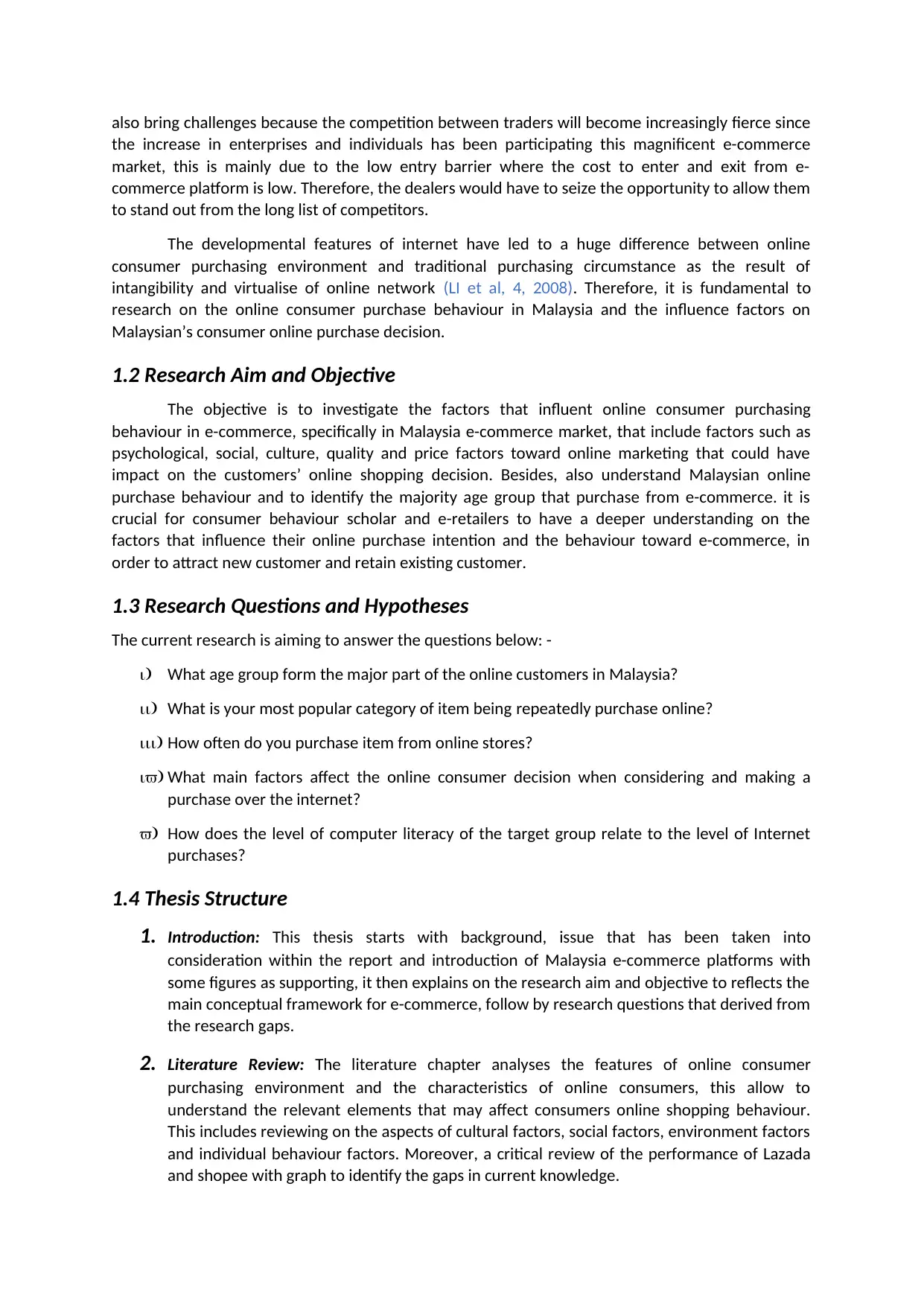
also bring challenges because the competition between traders will become increasingly fierce since
the increase in enterprises and individuals has been participating this magnificent e-commerce
market, this is mainly due to the low entry barrier where the cost to enter and exit from e-
commerce platform is low. Therefore, the dealers would have to seize the opportunity to allow them
to stand out from the long list of competitors.
The developmental features of internet have led to a huge difference between online
consumer purchasing environment and traditional purchasing circumstance as the result of
intangibility and virtualise of online network (LI et al, 4, 2008). Therefore, it is fundamental to
research on the online consumer purchase behaviour in Malaysia and the influence factors on
Malaysian’s consumer online purchase decision.
1.2 Research Aim and Objective
The objective is to investigate the factors that influent online consumer purchasing
behaviour in e-commerce, specifically in Malaysia e-commerce market, that include factors such as
psychological, social, culture, quality and price factors toward online marketing that could have
impact on the customers’ online shopping decision. Besides, also understand Malaysian online
purchase behaviour and to identify the majority age group that purchase from e-commerce. it is
crucial for consumer behaviour scholar and e-retailers to have a deeper understanding on the
factors that influence their online purchase intention and the behaviour toward e-commerce, in
order to attract new customer and retain existing customer.
1.3 Research Questions and Hypotheses
The current research is aiming to answer the questions below: -
i) What age group form the major part of the online customers in Malaysia?
ii) What is your most popular category of item being repeatedly purchase online?
iii) How often do you purchase item from online stores?
iv) What main factors affect the online consumer decision when considering and making a
purchase over the internet?
v) How does the level of computer literacy of the target group relate to the level of Internet
purchases?
1.4 Thesis Structure
1. Introduction: This thesis starts with background, issue that has been taken into
consideration within the report and introduction of Malaysia e-commerce platforms with
some figures as supporting, it then explains on the research aim and objective to reflects the
main conceptual framework for e-commerce, follow by research questions that derived from
the research gaps.
2. Literature Review: The literature chapter analyses the features of online consumer
purchasing environment and the characteristics of online consumers, this allow to
understand the relevant elements that may affect consumers online shopping behaviour.
This includes reviewing on the aspects of cultural factors, social factors, environment factors
and individual behaviour factors. Moreover, a critical review of the performance of Lazada
and shopee with graph to identify the gaps in current knowledge.
the increase in enterprises and individuals has been participating this magnificent e-commerce
market, this is mainly due to the low entry barrier where the cost to enter and exit from e-
commerce platform is low. Therefore, the dealers would have to seize the opportunity to allow them
to stand out from the long list of competitors.
The developmental features of internet have led to a huge difference between online
consumer purchasing environment and traditional purchasing circumstance as the result of
intangibility and virtualise of online network (LI et al, 4, 2008). Therefore, it is fundamental to
research on the online consumer purchase behaviour in Malaysia and the influence factors on
Malaysian’s consumer online purchase decision.
1.2 Research Aim and Objective
The objective is to investigate the factors that influent online consumer purchasing
behaviour in e-commerce, specifically in Malaysia e-commerce market, that include factors such as
psychological, social, culture, quality and price factors toward online marketing that could have
impact on the customers’ online shopping decision. Besides, also understand Malaysian online
purchase behaviour and to identify the majority age group that purchase from e-commerce. it is
crucial for consumer behaviour scholar and e-retailers to have a deeper understanding on the
factors that influence their online purchase intention and the behaviour toward e-commerce, in
order to attract new customer and retain existing customer.
1.3 Research Questions and Hypotheses
The current research is aiming to answer the questions below: -
i) What age group form the major part of the online customers in Malaysia?
ii) What is your most popular category of item being repeatedly purchase online?
iii) How often do you purchase item from online stores?
iv) What main factors affect the online consumer decision when considering and making a
purchase over the internet?
v) How does the level of computer literacy of the target group relate to the level of Internet
purchases?
1.4 Thesis Structure
1. Introduction: This thesis starts with background, issue that has been taken into
consideration within the report and introduction of Malaysia e-commerce platforms with
some figures as supporting, it then explains on the research aim and objective to reflects the
main conceptual framework for e-commerce, follow by research questions that derived from
the research gaps.
2. Literature Review: The literature chapter analyses the features of online consumer
purchasing environment and the characteristics of online consumers, this allow to
understand the relevant elements that may affect consumers online shopping behaviour.
This includes reviewing on the aspects of cultural factors, social factors, environment factors
and individual behaviour factors. Moreover, a critical review of the performance of Lazada
and shopee with graph to identify the gaps in current knowledge.
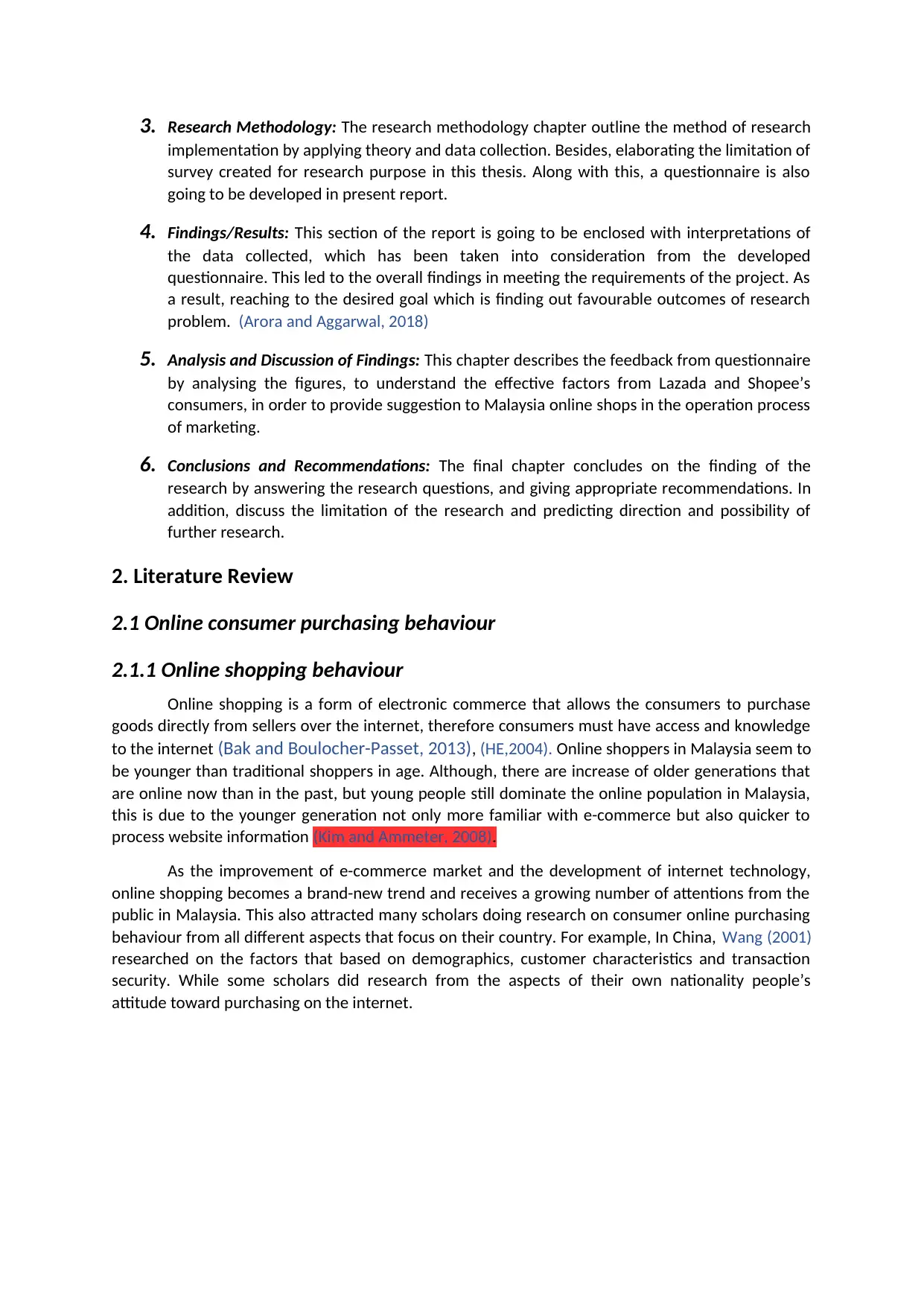
3. Research Methodology: The research methodology chapter outline the method of research
implementation by applying theory and data collection. Besides, elaborating the limitation of
survey created for research purpose in this thesis. Along with this, a questionnaire is also
going to be developed in present report.
4. Findings/Results: This section of the report is going to be enclosed with interpretations of
the data collected, which has been taken into consideration from the developed
questionnaire. This led to the overall findings in meeting the requirements of the project. As
a result, reaching to the desired goal which is finding out favourable outcomes of research
problem. (Arora and Aggarwal, 2018)
5. Analysis and Discussion of Findings: This chapter describes the feedback from questionnaire
by analysing the figures, to understand the effective factors from Lazada and Shopee’s
consumers, in order to provide suggestion to Malaysia online shops in the operation process
of marketing.
6. Conclusions and Recommendations: The final chapter concludes on the finding of the
research by answering the research questions, and giving appropriate recommendations. In
addition, discuss the limitation of the research and predicting direction and possibility of
further research.
2. Literature Review
2.1 Online consumer purchasing behaviour
2.1.1 Online shopping behaviour
Online shopping is a form of electronic commerce that allows the consumers to purchase
goods directly from sellers over the internet, therefore consumers must have access and knowledge
to the internet (Bak and Boulocher-Passet, 2013), (HE,2004). Online shoppers in Malaysia seem to
be younger than traditional shoppers in age. Although, there are increase of older generations that
are online now than in the past, but young people still dominate the online population in Malaysia,
this is due to the younger generation not only more familiar with e-commerce but also quicker to
process website information (Kim and Ammeter, 2008).
As the improvement of e-commerce market and the development of internet technology,
online shopping becomes a brand-new trend and receives a growing number of attentions from the
public in Malaysia. This also attracted many scholars doing research on consumer online purchasing
behaviour from all different aspects that focus on their country. For example, In China, Wang (2001)
researched on the factors that based on demographics, customer characteristics and transaction
security. While some scholars did research from the aspects of their own nationality people’s
attitude toward purchasing on the internet.
implementation by applying theory and data collection. Besides, elaborating the limitation of
survey created for research purpose in this thesis. Along with this, a questionnaire is also
going to be developed in present report.
4. Findings/Results: This section of the report is going to be enclosed with interpretations of
the data collected, which has been taken into consideration from the developed
questionnaire. This led to the overall findings in meeting the requirements of the project. As
a result, reaching to the desired goal which is finding out favourable outcomes of research
problem. (Arora and Aggarwal, 2018)
5. Analysis and Discussion of Findings: This chapter describes the feedback from questionnaire
by analysing the figures, to understand the effective factors from Lazada and Shopee’s
consumers, in order to provide suggestion to Malaysia online shops in the operation process
of marketing.
6. Conclusions and Recommendations: The final chapter concludes on the finding of the
research by answering the research questions, and giving appropriate recommendations. In
addition, discuss the limitation of the research and predicting direction and possibility of
further research.
2. Literature Review
2.1 Online consumer purchasing behaviour
2.1.1 Online shopping behaviour
Online shopping is a form of electronic commerce that allows the consumers to purchase
goods directly from sellers over the internet, therefore consumers must have access and knowledge
to the internet (Bak and Boulocher-Passet, 2013), (HE,2004). Online shoppers in Malaysia seem to
be younger than traditional shoppers in age. Although, there are increase of older generations that
are online now than in the past, but young people still dominate the online population in Malaysia,
this is due to the younger generation not only more familiar with e-commerce but also quicker to
process website information (Kim and Ammeter, 2008).
As the improvement of e-commerce market and the development of internet technology,
online shopping becomes a brand-new trend and receives a growing number of attentions from the
public in Malaysia. This also attracted many scholars doing research on consumer online purchasing
behaviour from all different aspects that focus on their country. For example, In China, Wang (2001)
researched on the factors that based on demographics, customer characteristics and transaction
security. While some scholars did research from the aspects of their own nationality people’s
attitude toward purchasing on the internet.
⊘ This is a preview!⊘
Do you want full access?
Subscribe today to unlock all pages.

Trusted by 1+ million students worldwide
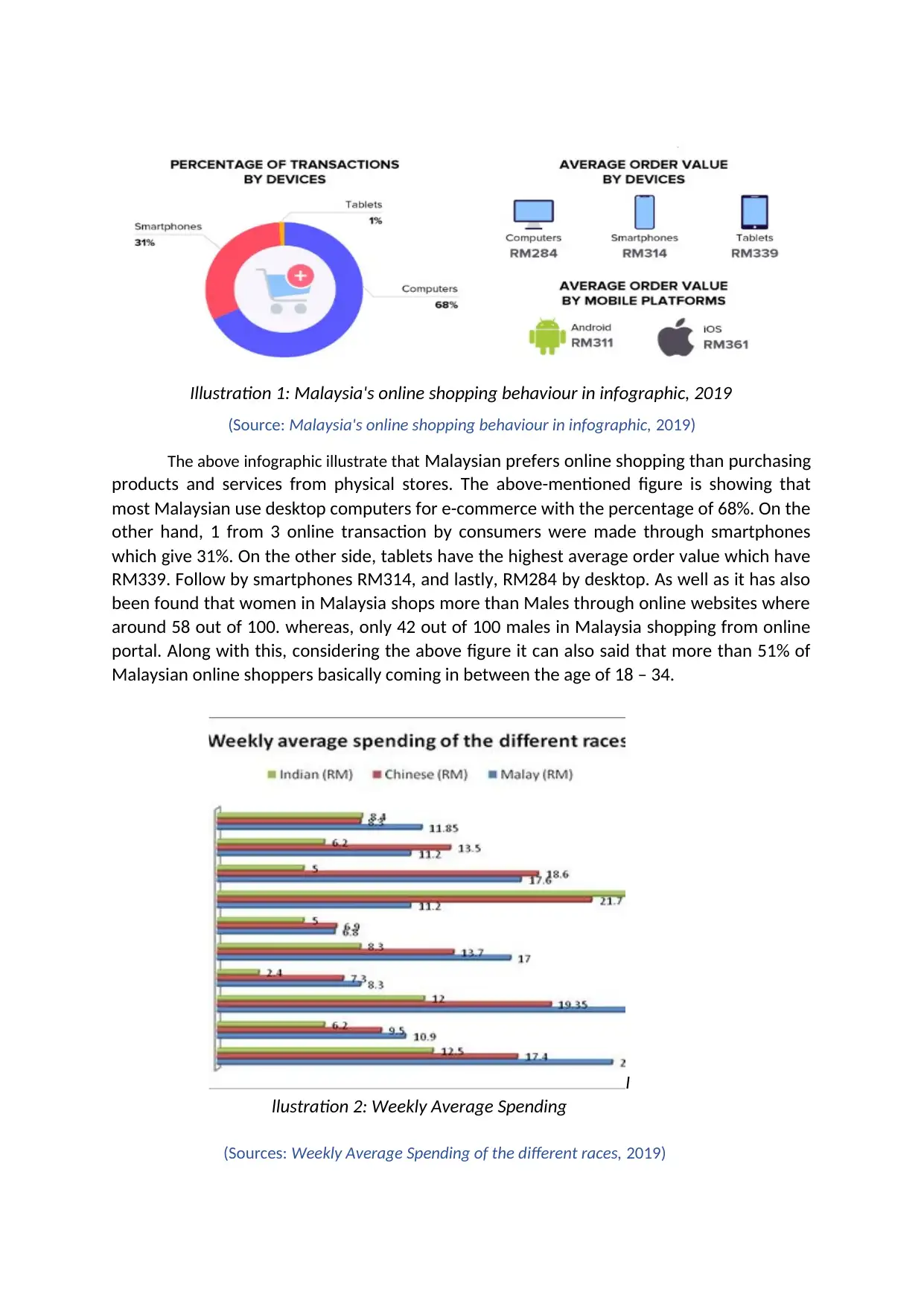
(Source: Malaysia's online shopping behaviour in infographic, 2019)
The above infographic illustrate that Malaysian prefers online shopping than purchasing
products and services from physical stores. The above-mentioned figure is showing that
most Malaysian use desktop computers for e-commerce with the percentage of 68%. On the
other hand, 1 from 3 online transaction by consumers were made through smartphones
which give 31%. On the other side, tablets have the highest average order value which have
RM339. Follow by smartphones RM314, and lastly, RM284 by desktop. As well as it has also
been found that women in Malaysia shops more than Males through online websites where
around 58 out of 100. whereas, only 42 out of 100 males in Malaysia shopping from online
portal. Along with this, considering the above figure it can also said that more than 51% of
Malaysian online shoppers basically coming in between the age of 18 – 34.
(Sources: Weekly Average Spending of the different races, 2019)
I
llustration 2: Weekly Average Spending
Illustration 1: Malaysia's online shopping behaviour in infographic, 2019
The above infographic illustrate that Malaysian prefers online shopping than purchasing
products and services from physical stores. The above-mentioned figure is showing that
most Malaysian use desktop computers for e-commerce with the percentage of 68%. On the
other hand, 1 from 3 online transaction by consumers were made through smartphones
which give 31%. On the other side, tablets have the highest average order value which have
RM339. Follow by smartphones RM314, and lastly, RM284 by desktop. As well as it has also
been found that women in Malaysia shops more than Males through online websites where
around 58 out of 100. whereas, only 42 out of 100 males in Malaysia shopping from online
portal. Along with this, considering the above figure it can also said that more than 51% of
Malaysian online shoppers basically coming in between the age of 18 – 34.
(Sources: Weekly Average Spending of the different races, 2019)
I
llustration 2: Weekly Average Spending
Illustration 1: Malaysia's online shopping behaviour in infographic, 2019
Paraphrase This Document
Need a fresh take? Get an instant paraphrase of this document with our AI Paraphraser
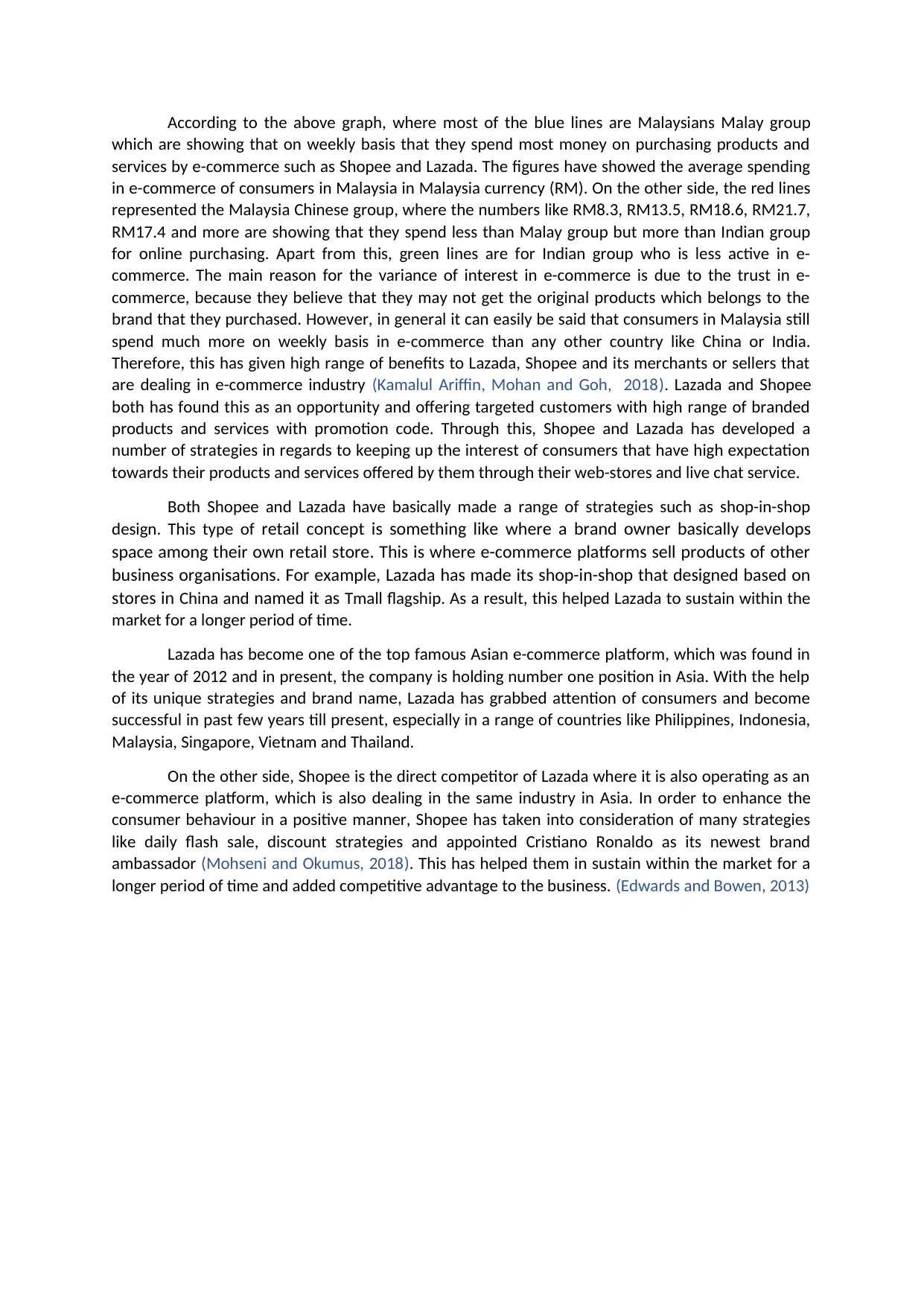
According to the above graph, where most of the blue lines are Malaysians Malay group
which are showing that on weekly basis that they spend most money on purchasing products and
services by e-commerce such as Shopee and Lazada. The figures have showed the average spending
in e-commerce of consumers in Malaysia in Malaysia currency (RM). On the other side, the red lines
represented the Malaysia Chinese group, where the numbers like RM8.3, RM13.5, RM18.6, RM21.7,
RM17.4 and more are showing that they spend less than Malay group but more than Indian group
for online purchasing. Apart from this, green lines are for Indian group who is less active in e-
commerce. The main reason for the variance of interest in e-commerce is due to the trust in e-
commerce, because they believe that they may not get the original products which belongs to the
brand that they purchased. However, in general it can easily be said that consumers in Malaysia still
spend much more on weekly basis in e-commerce than any other country like China or India.
Therefore, this has given high range of benefits to Lazada, Shopee and its merchants or sellers that
are dealing in e-commerce industry (Kamalul Ariffin, Mohan and Goh, 2018). Lazada and Shopee
both has found this as an opportunity and offering targeted customers with high range of branded
products and services with promotion code. Through this, Shopee and Lazada has developed a
number of strategies in regards to keeping up the interest of consumers that have high expectation
towards their products and services offered by them through their web-stores and live chat service.
Both Shopee and Lazada have basically made a range of strategies such as shop-in-shop
design. This type of retail concept is something like where a brand owner basically develops
space among their own retail store. This is where e-commerce platforms sell products of other
business organisations. For example, Lazada has made its shop-in-shop that designed based on
stores in China and named it as Tmall flagship. As a result, this helped Lazada to sustain within the
market for a longer period of time.
Lazada has become one of the top famous Asian e-commerce platform, which was found in
the year of 2012 and in present, the company is holding number one position in Asia. With the help
of its unique strategies and brand name, Lazada has grabbed attention of consumers and become
successful in past few years till present, especially in a range of countries like Philippines, Indonesia,
Malaysia, Singapore, Vietnam and Thailand.
On the other side, Shopee is the direct competitor of Lazada where it is also operating as an
e-commerce platform, which is also dealing in the same industry in Asia. In order to enhance the
consumer behaviour in a positive manner, Shopee has taken into consideration of many strategies
like daily flash sale, discount strategies and appointed Cristiano Ronaldo as its newest brand
ambassador (Mohseni and Okumus, 2018). This has helped them in sustain within the market for a
longer period of time and added competitive advantage to the business. (Edwards and Bowen, 2013)
which are showing that on weekly basis that they spend most money on purchasing products and
services by e-commerce such as Shopee and Lazada. The figures have showed the average spending
in e-commerce of consumers in Malaysia in Malaysia currency (RM). On the other side, the red lines
represented the Malaysia Chinese group, where the numbers like RM8.3, RM13.5, RM18.6, RM21.7,
RM17.4 and more are showing that they spend less than Malay group but more than Indian group
for online purchasing. Apart from this, green lines are for Indian group who is less active in e-
commerce. The main reason for the variance of interest in e-commerce is due to the trust in e-
commerce, because they believe that they may not get the original products which belongs to the
brand that they purchased. However, in general it can easily be said that consumers in Malaysia still
spend much more on weekly basis in e-commerce than any other country like China or India.
Therefore, this has given high range of benefits to Lazada, Shopee and its merchants or sellers that
are dealing in e-commerce industry (Kamalul Ariffin, Mohan and Goh, 2018). Lazada and Shopee
both has found this as an opportunity and offering targeted customers with high range of branded
products and services with promotion code. Through this, Shopee and Lazada has developed a
number of strategies in regards to keeping up the interest of consumers that have high expectation
towards their products and services offered by them through their web-stores and live chat service.
Both Shopee and Lazada have basically made a range of strategies such as shop-in-shop
design. This type of retail concept is something like where a brand owner basically develops
space among their own retail store. This is where e-commerce platforms sell products of other
business organisations. For example, Lazada has made its shop-in-shop that designed based on
stores in China and named it as Tmall flagship. As a result, this helped Lazada to sustain within the
market for a longer period of time.
Lazada has become one of the top famous Asian e-commerce platform, which was found in
the year of 2012 and in present, the company is holding number one position in Asia. With the help
of its unique strategies and brand name, Lazada has grabbed attention of consumers and become
successful in past few years till present, especially in a range of countries like Philippines, Indonesia,
Malaysia, Singapore, Vietnam and Thailand.
On the other side, Shopee is the direct competitor of Lazada where it is also operating as an
e-commerce platform, which is also dealing in the same industry in Asia. In order to enhance the
consumer behaviour in a positive manner, Shopee has taken into consideration of many strategies
like daily flash sale, discount strategies and appointed Cristiano Ronaldo as its newest brand
ambassador (Mohseni and Okumus, 2018). This has helped them in sustain within the market for a
longer period of time and added competitive advantage to the business. (Edwards and Bowen, 2013)
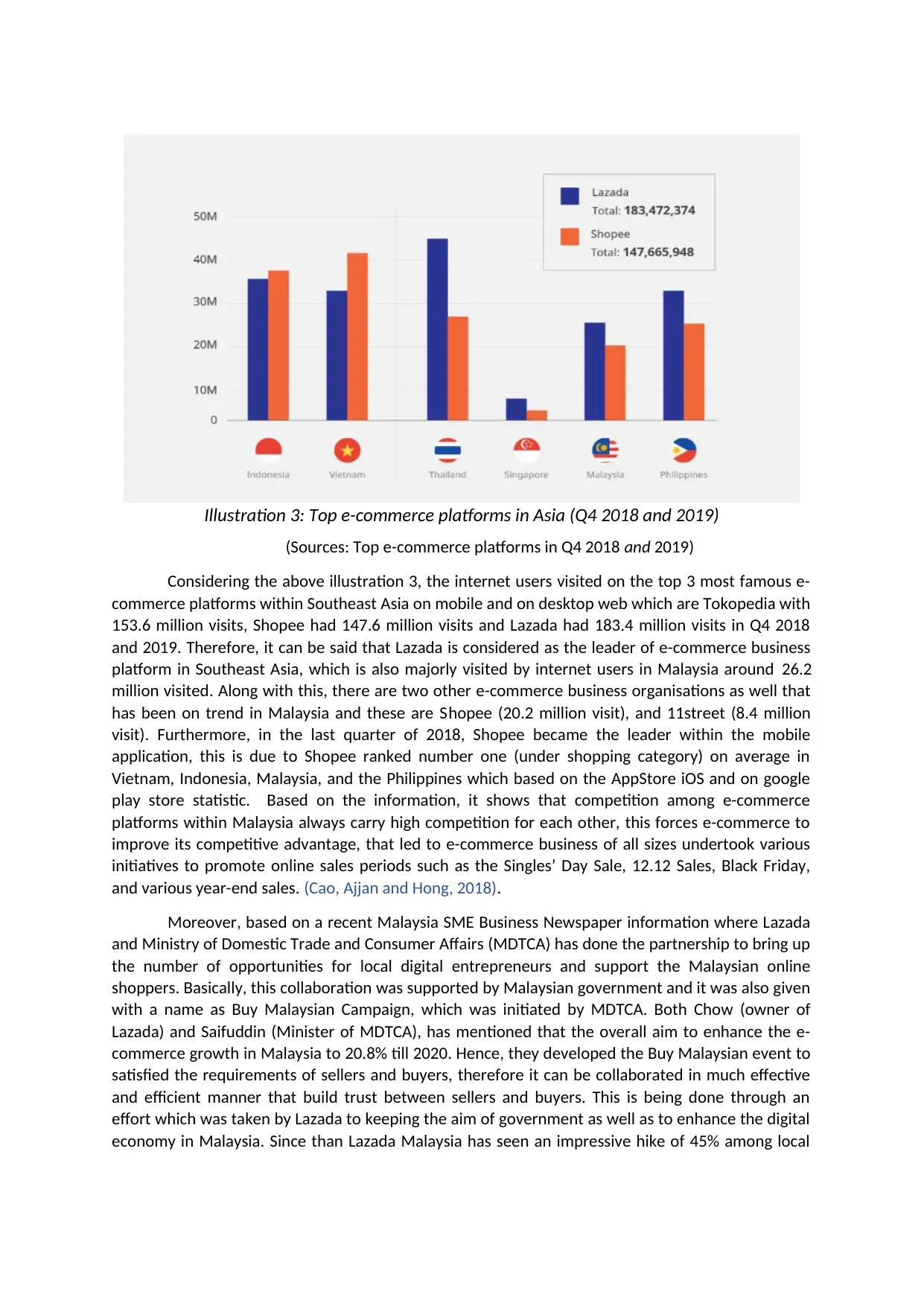
(Sources: Top e-commerce platforms in Q4 2018 and 2019)
Considering the above illustration 3, the internet users visited on the top 3 most famous e-
commerce platforms within Southeast Asia on mobile and on desktop web which are Tokopedia with
153.6 million visits, Shopee had 147.6 million visits and Lazada had 183.4 million visits in Q4 2018
and 2019. Therefore, it can be said that Lazada is considered as the leader of e-commerce business
platform in Southeast Asia, which is also majorly visited by internet users in Malaysia around 26.2
million visited. Along with this, there are two other e-commerce business organisations as well that
has been on trend in Malaysia and these are Shopee (20.2 million visit), and 11street (8.4 million
visit). Furthermore, in the last quarter of 2018, Shopee became the leader within the mobile
application, this is due to Shopee ranked number one (under shopping category) on average in
Vietnam, Indonesia, Malaysia, and the Philippines which based on the AppStore iOS and on google
play store statistic. Based on the information, it shows that competition among e-commerce
platforms within Malaysia always carry high competition for each other, this forces e-commerce to
improve its competitive advantage, that led to e-commerce business of all sizes undertook various
initiatives to promote online sales periods such as the Singles’ Day Sale, 12.12 Sales, Black Friday,
and various year-end sales. (Cao, Ajjan and Hong, 2018).
Moreover, based on a recent Malaysia SME Business Newspaper information where Lazada
and Ministry of Domestic Trade and Consumer Affairs (MDTCA) has done the partnership to bring up
the number of opportunities for local digital entrepreneurs and support the Malaysian online
shoppers. Basically, this collaboration was supported by Malaysian government and it was also given
with a name as Buy Malaysian Campaign, which was initiated by MDTCA. Both Chow (owner of
Lazada) and Saifuddin (Minister of MDTCA), has mentioned that the overall aim to enhance the e-
commerce growth in Malaysia to 20.8% till 2020. Hence, they developed the Buy Malaysian event to
satisfied the requirements of sellers and buyers, therefore it can be collaborated in much effective
and efficient manner that build trust between sellers and buyers. This is being done through an
effort which was taken by Lazada to keeping the aim of government as well as to enhance the digital
economy in Malaysia. Since than Lazada Malaysia has seen an impressive hike of 45% among local
Illustration 3: Top e-commerce platforms in Asia (Q4 2018 and 2019)
Considering the above illustration 3, the internet users visited on the top 3 most famous e-
commerce platforms within Southeast Asia on mobile and on desktop web which are Tokopedia with
153.6 million visits, Shopee had 147.6 million visits and Lazada had 183.4 million visits in Q4 2018
and 2019. Therefore, it can be said that Lazada is considered as the leader of e-commerce business
platform in Southeast Asia, which is also majorly visited by internet users in Malaysia around 26.2
million visited. Along with this, there are two other e-commerce business organisations as well that
has been on trend in Malaysia and these are Shopee (20.2 million visit), and 11street (8.4 million
visit). Furthermore, in the last quarter of 2018, Shopee became the leader within the mobile
application, this is due to Shopee ranked number one (under shopping category) on average in
Vietnam, Indonesia, Malaysia, and the Philippines which based on the AppStore iOS and on google
play store statistic. Based on the information, it shows that competition among e-commerce
platforms within Malaysia always carry high competition for each other, this forces e-commerce to
improve its competitive advantage, that led to e-commerce business of all sizes undertook various
initiatives to promote online sales periods such as the Singles’ Day Sale, 12.12 Sales, Black Friday,
and various year-end sales. (Cao, Ajjan and Hong, 2018).
Moreover, based on a recent Malaysia SME Business Newspaper information where Lazada
and Ministry of Domestic Trade and Consumer Affairs (MDTCA) has done the partnership to bring up
the number of opportunities for local digital entrepreneurs and support the Malaysian online
shoppers. Basically, this collaboration was supported by Malaysian government and it was also given
with a name as Buy Malaysian Campaign, which was initiated by MDTCA. Both Chow (owner of
Lazada) and Saifuddin (Minister of MDTCA), has mentioned that the overall aim to enhance the e-
commerce growth in Malaysia to 20.8% till 2020. Hence, they developed the Buy Malaysian event to
satisfied the requirements of sellers and buyers, therefore it can be collaborated in much effective
and efficient manner that build trust between sellers and buyers. This is being done through an
effort which was taken by Lazada to keeping the aim of government as well as to enhance the digital
economy in Malaysia. Since than Lazada Malaysia has seen an impressive hike of 45% among local
Illustration 3: Top e-commerce platforms in Asia (Q4 2018 and 2019)
⊘ This is a preview!⊘
Do you want full access?
Subscribe today to unlock all pages.

Trusted by 1+ million students worldwide
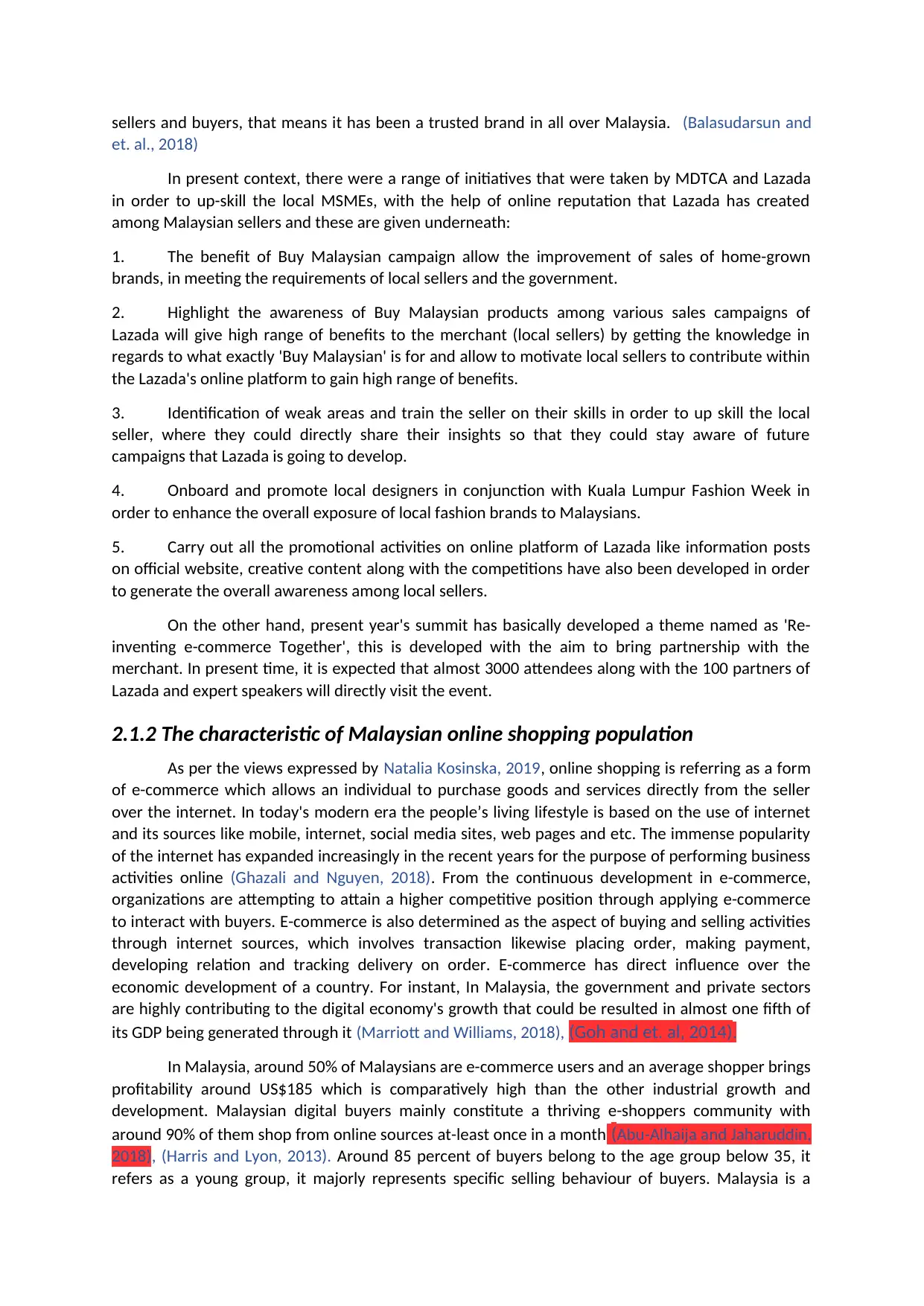
sellers and buyers, that means it has been a trusted brand in all over Malaysia. (Balasudarsun and
et. al., 2018)
In present context, there were a range of initiatives that were taken by MDTCA and Lazada
in order to up-skill the local MSMEs, with the help of online reputation that Lazada has created
among Malaysian sellers and these are given underneath:
1. The benefit of Buy Malaysian campaign allow the improvement of sales of home-grown
brands, in meeting the requirements of local sellers and the government.
2. Highlight the awareness of Buy Malaysian products among various sales campaigns of
Lazada will give high range of benefits to the merchant (local sellers) by getting the knowledge in
regards to what exactly 'Buy Malaysian' is for and allow to motivate local sellers to contribute within
the Lazada's online platform to gain high range of benefits.
3. Identification of weak areas and train the seller on their skills in order to up skill the local
seller, where they could directly share their insights so that they could stay aware of future
campaigns that Lazada is going to develop.
4. Onboard and promote local designers in conjunction with Kuala Lumpur Fashion Week in
order to enhance the overall exposure of local fashion brands to Malaysians.
5. Carry out all the promotional activities on online platform of Lazada like information posts
on official website, creative content along with the competitions have also been developed in order
to generate the overall awareness among local sellers.
On the other hand, present year's summit has basically developed a theme named as 'Re-
inventing e-commerce Together', this is developed with the aim to bring partnership with the
merchant. In present time, it is expected that almost 3000 attendees along with the 100 partners of
Lazada and expert speakers will directly visit the event.
2.1.2 The characteristic of Malaysian online shopping population
As per the views expressed by Natalia Kosinska, 2019, online shopping is referring as a form
of e-commerce which allows an individual to purchase goods and services directly from the seller
over the internet. In today's modern era the people’s living lifestyle is based on the use of internet
and its sources like mobile, internet, social media sites, web pages and etc. The immense popularity
of the internet has expanded increasingly in the recent years for the purpose of performing business
activities online (Ghazali and Nguyen, 2018). From the continuous development in e-commerce,
organizations are attempting to attain a higher competitive position through applying e-commerce
to interact with buyers. E-commerce is also determined as the aspect of buying and selling activities
through internet sources, which involves transaction likewise placing order, making payment,
developing relation and tracking delivery on order. E-commerce has direct influence over the
economic development of a country. For instant, In Malaysia, the government and private sectors
are highly contributing to the digital economy's growth that could be resulted in almost one fifth of
its GDP being generated through it (Marriott and Williams, 2018), (Goh and et. al, 2014).
In Malaysia, around 50% of Malaysians are e-commerce users and an average shopper brings
profitability around US$185 which is comparatively high than the other industrial growth and
development. Malaysian digital buyers mainly constitute a thriving e-shoppers community with
around 90% of them shop from online sources at-least once in a month (Abu-Alhaija and Jaharuddin,
2018), (Harris and Lyon, 2013). Around 85 percent of buyers belong to the age group below 35, it
refers as a young group, it majorly represents specific selling behaviour of buyers. Malaysia is a
et. al., 2018)
In present context, there were a range of initiatives that were taken by MDTCA and Lazada
in order to up-skill the local MSMEs, with the help of online reputation that Lazada has created
among Malaysian sellers and these are given underneath:
1. The benefit of Buy Malaysian campaign allow the improvement of sales of home-grown
brands, in meeting the requirements of local sellers and the government.
2. Highlight the awareness of Buy Malaysian products among various sales campaigns of
Lazada will give high range of benefits to the merchant (local sellers) by getting the knowledge in
regards to what exactly 'Buy Malaysian' is for and allow to motivate local sellers to contribute within
the Lazada's online platform to gain high range of benefits.
3. Identification of weak areas and train the seller on their skills in order to up skill the local
seller, where they could directly share their insights so that they could stay aware of future
campaigns that Lazada is going to develop.
4. Onboard and promote local designers in conjunction with Kuala Lumpur Fashion Week in
order to enhance the overall exposure of local fashion brands to Malaysians.
5. Carry out all the promotional activities on online platform of Lazada like information posts
on official website, creative content along with the competitions have also been developed in order
to generate the overall awareness among local sellers.
On the other hand, present year's summit has basically developed a theme named as 'Re-
inventing e-commerce Together', this is developed with the aim to bring partnership with the
merchant. In present time, it is expected that almost 3000 attendees along with the 100 partners of
Lazada and expert speakers will directly visit the event.
2.1.2 The characteristic of Malaysian online shopping population
As per the views expressed by Natalia Kosinska, 2019, online shopping is referring as a form
of e-commerce which allows an individual to purchase goods and services directly from the seller
over the internet. In today's modern era the people’s living lifestyle is based on the use of internet
and its sources like mobile, internet, social media sites, web pages and etc. The immense popularity
of the internet has expanded increasingly in the recent years for the purpose of performing business
activities online (Ghazali and Nguyen, 2018). From the continuous development in e-commerce,
organizations are attempting to attain a higher competitive position through applying e-commerce
to interact with buyers. E-commerce is also determined as the aspect of buying and selling activities
through internet sources, which involves transaction likewise placing order, making payment,
developing relation and tracking delivery on order. E-commerce has direct influence over the
economic development of a country. For instant, In Malaysia, the government and private sectors
are highly contributing to the digital economy's growth that could be resulted in almost one fifth of
its GDP being generated through it (Marriott and Williams, 2018), (Goh and et. al, 2014).
In Malaysia, around 50% of Malaysians are e-commerce users and an average shopper brings
profitability around US$185 which is comparatively high than the other industrial growth and
development. Malaysian digital buyers mainly constitute a thriving e-shoppers community with
around 90% of them shop from online sources at-least once in a month (Abu-Alhaija and Jaharuddin,
2018), (Harris and Lyon, 2013). Around 85 percent of buyers belong to the age group below 35, it
refers as a young group, it majorly represents specific selling behaviour of buyers. Malaysia is a
Paraphrase This Document
Need a fresh take? Get an instant paraphrase of this document with our AI Paraphraser
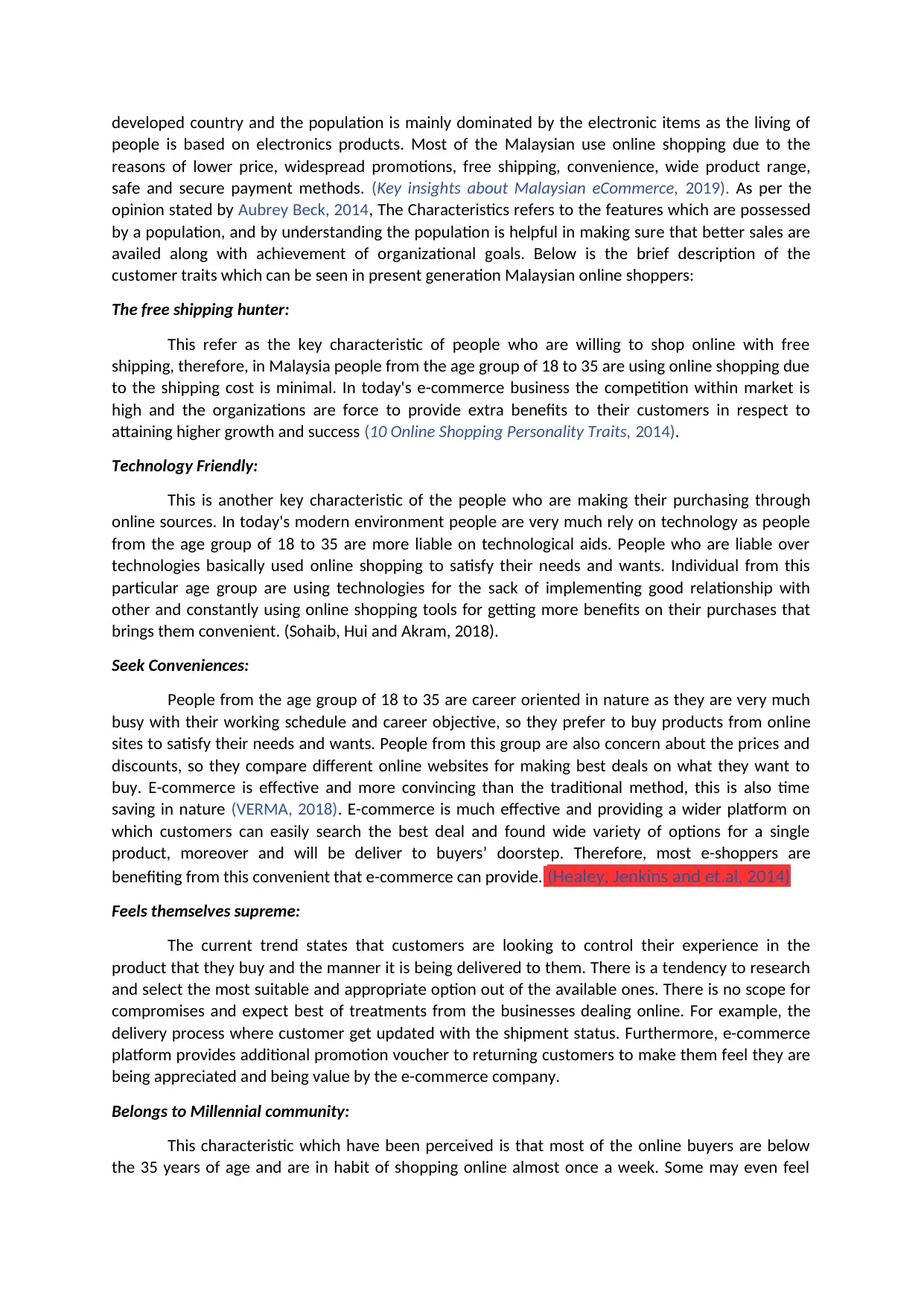
developed country and the population is mainly dominated by the electronic items as the living of
people is based on electronics products. Most of the Malaysian use online shopping due to the
reasons of lower price, widespread promotions, free shipping, convenience, wide product range,
safe and secure payment methods. (Key insights about Malaysian eCommerce, 2019). As per the
opinion stated by Aubrey Beck, 2014, The Characteristics refers to the features which are possessed
by a population, and by understanding the population is helpful in making sure that better sales are
availed along with achievement of organizational goals. Below is the brief description of the
customer traits which can be seen in present generation Malaysian online shoppers:
The free shipping hunter:
This refer as the key characteristic of people who are willing to shop online with free
shipping, therefore, in Malaysia people from the age group of 18 to 35 are using online shopping due
to the shipping cost is minimal. In today's e-commerce business the competition within market is
high and the organizations are force to provide extra benefits to their customers in respect to
attaining higher growth and success (10 Online Shopping Personality Traits, 2014).
Technology Friendly:
This is another key characteristic of the people who are making their purchasing through
online sources. In today's modern environment people are very much rely on technology as people
from the age group of 18 to 35 are more liable on technological aids. People who are liable over
technologies basically used online shopping to satisfy their needs and wants. Individual from this
particular age group are using technologies for the sack of implementing good relationship with
other and constantly using online shopping tools for getting more benefits on their purchases that
brings them convenient. (Sohaib, Hui and Akram, 2018).
Seek Conveniences:
People from the age group of 18 to 35 are career oriented in nature as they are very much
busy with their working schedule and career objective, so they prefer to buy products from online
sites to satisfy their needs and wants. People from this group are also concern about the prices and
discounts, so they compare different online websites for making best deals on what they want to
buy. E-commerce is effective and more convincing than the traditional method, this is also time
saving in nature (VERMA, 2018). E-commerce is much effective and providing a wider platform on
which customers can easily search the best deal and found wide variety of options for a single
product, moreover and will be deliver to buyers’ doorstep. Therefore, most e-shoppers are
benefiting from this convenient that e-commerce can provide. (Healey, Jenkins and et.al, 2014)
Feels themselves supreme:
The current trend states that customers are looking to control their experience in the
product that they buy and the manner it is being delivered to them. There is a tendency to research
and select the most suitable and appropriate option out of the available ones. There is no scope for
compromises and expect best of treatments from the businesses dealing online. For example, the
delivery process where customer get updated with the shipment status. Furthermore, e-commerce
platform provides additional promotion voucher to returning customers to make them feel they are
being appreciated and being value by the e-commerce company.
Belongs to Millennial community:
This characteristic which have been perceived is that most of the online buyers are below
the 35 years of age and are in habit of shopping online almost once a week. Some may even feel
people is based on electronics products. Most of the Malaysian use online shopping due to the
reasons of lower price, widespread promotions, free shipping, convenience, wide product range,
safe and secure payment methods. (Key insights about Malaysian eCommerce, 2019). As per the
opinion stated by Aubrey Beck, 2014, The Characteristics refers to the features which are possessed
by a population, and by understanding the population is helpful in making sure that better sales are
availed along with achievement of organizational goals. Below is the brief description of the
customer traits which can be seen in present generation Malaysian online shoppers:
The free shipping hunter:
This refer as the key characteristic of people who are willing to shop online with free
shipping, therefore, in Malaysia people from the age group of 18 to 35 are using online shopping due
to the shipping cost is minimal. In today's e-commerce business the competition within market is
high and the organizations are force to provide extra benefits to their customers in respect to
attaining higher growth and success (10 Online Shopping Personality Traits, 2014).
Technology Friendly:
This is another key characteristic of the people who are making their purchasing through
online sources. In today's modern environment people are very much rely on technology as people
from the age group of 18 to 35 are more liable on technological aids. People who are liable over
technologies basically used online shopping to satisfy their needs and wants. Individual from this
particular age group are using technologies for the sack of implementing good relationship with
other and constantly using online shopping tools for getting more benefits on their purchases that
brings them convenient. (Sohaib, Hui and Akram, 2018).
Seek Conveniences:
People from the age group of 18 to 35 are career oriented in nature as they are very much
busy with their working schedule and career objective, so they prefer to buy products from online
sites to satisfy their needs and wants. People from this group are also concern about the prices and
discounts, so they compare different online websites for making best deals on what they want to
buy. E-commerce is effective and more convincing than the traditional method, this is also time
saving in nature (VERMA, 2018). E-commerce is much effective and providing a wider platform on
which customers can easily search the best deal and found wide variety of options for a single
product, moreover and will be deliver to buyers’ doorstep. Therefore, most e-shoppers are
benefiting from this convenient that e-commerce can provide. (Healey, Jenkins and et.al, 2014)
Feels themselves supreme:
The current trend states that customers are looking to control their experience in the
product that they buy and the manner it is being delivered to them. There is a tendency to research
and select the most suitable and appropriate option out of the available ones. There is no scope for
compromises and expect best of treatments from the businesses dealing online. For example, the
delivery process where customer get updated with the shipment status. Furthermore, e-commerce
platform provides additional promotion voucher to returning customers to make them feel they are
being appreciated and being value by the e-commerce company.
Belongs to Millennial community:
This characteristic which have been perceived is that most of the online buyers are below
the 35 years of age and are in habit of shopping online almost once a week. Some may even feel
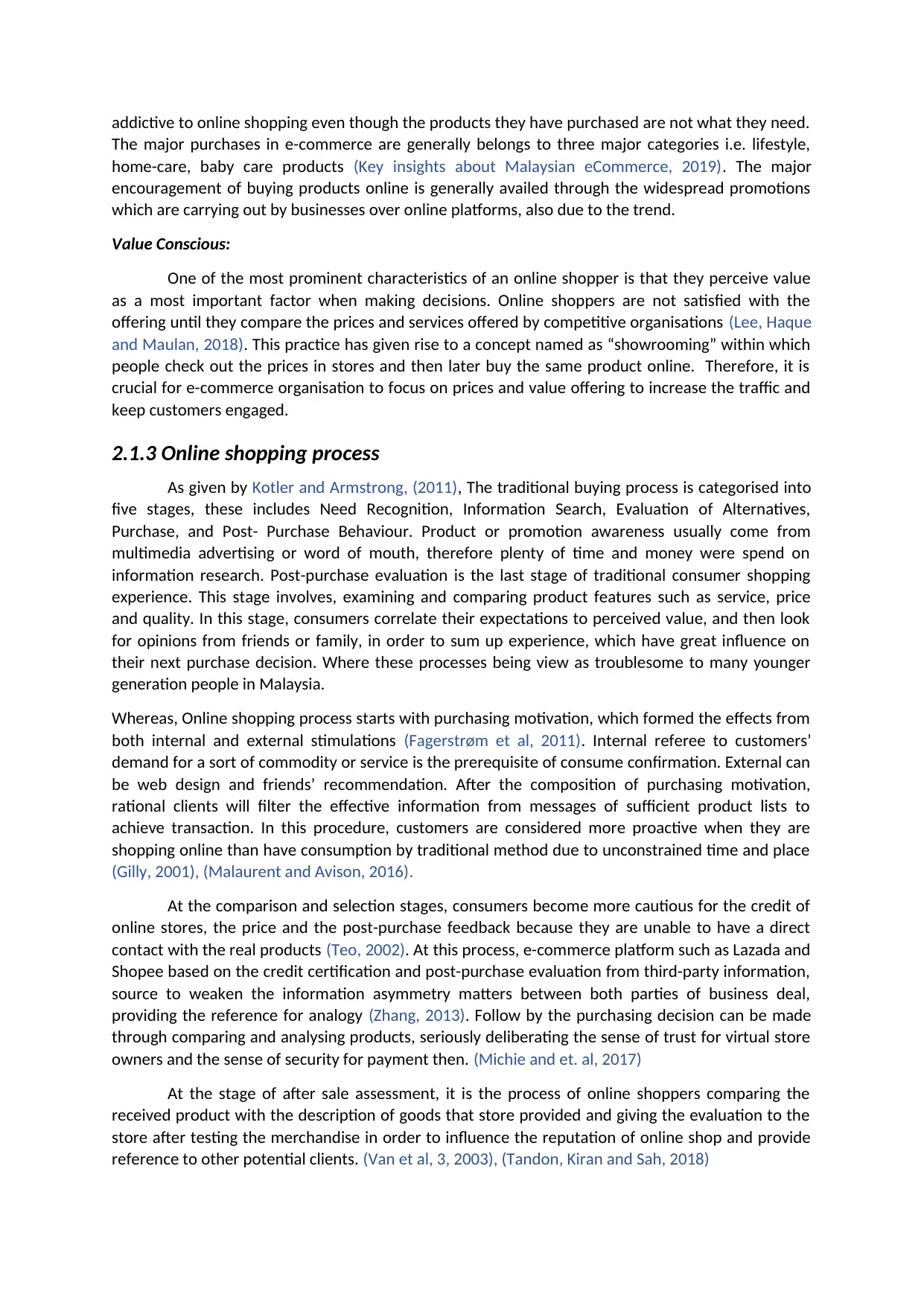
addictive to online shopping even though the products they have purchased are not what they need.
The major purchases in e-commerce are generally belongs to three major categories i.e. lifestyle,
home-care, baby care products (Key insights about Malaysian eCommerce, 2019). The major
encouragement of buying products online is generally availed through the widespread promotions
which are carrying out by businesses over online platforms, also due to the trend.
Value Conscious:
One of the most prominent characteristics of an online shopper is that they perceive value
as a most important factor when making decisions. Online shoppers are not satisfied with the
offering until they compare the prices and services offered by competitive organisations (Lee, Haque
and Maulan, 2018). This practice has given rise to a concept named as “showrooming” within which
people check out the prices in stores and then later buy the same product online. Therefore, it is
crucial for e-commerce organisation to focus on prices and value offering to increase the traffic and
keep customers engaged.
2.1.3 Online shopping process
As given by Kotler and Armstrong, (2011), The traditional buying process is categorised into
five stages, these includes Need Recognition, Information Search, Evaluation of Alternatives,
Purchase, and Post- Purchase Behaviour. Product or promotion awareness usually come from
multimedia advertising or word of mouth, therefore plenty of time and money were spend on
information research. Post-purchase evaluation is the last stage of traditional consumer shopping
experience. This stage involves, examining and comparing product features such as service, price
and quality. In this stage, consumers correlate their expectations to perceived value, and then look
for opinions from friends or family, in order to sum up experience, which have great influence on
their next purchase decision. Where these processes being view as troublesome to many younger
generation people in Malaysia.
Whereas, Online shopping process starts with purchasing motivation, which formed the effects from
both internal and external stimulations (Fagerstrøm et al, 2011). Internal referee to customers’
demand for a sort of commodity or service is the prerequisite of consume confirmation. External can
be web design and friends’ recommendation. After the composition of purchasing motivation,
rational clients will filter the effective information from messages of sufficient product lists to
achieve transaction. In this procedure, customers are considered more proactive when they are
shopping online than have consumption by traditional method due to unconstrained time and place
(Gilly, 2001), (Malaurent and Avison, 2016).
At the comparison and selection stages, consumers become more cautious for the credit of
online stores, the price and the post-purchase feedback because they are unable to have a direct
contact with the real products (Teo, 2002). At this process, e-commerce platform such as Lazada and
Shopee based on the credit certification and post-purchase evaluation from third-party information,
source to weaken the information asymmetry matters between both parties of business deal,
providing the reference for analogy (Zhang, 2013). Follow by the purchasing decision can be made
through comparing and analysing products, seriously deliberating the sense of trust for virtual store
owners and the sense of security for payment then. (Michie and et. al, 2017)
At the stage of after sale assessment, it is the process of online shoppers comparing the
received product with the description of goods that store provided and giving the evaluation to the
store after testing the merchandise in order to influence the reputation of online shop and provide
reference to other potential clients. (Van et al, 3, 2003), (Tandon, Kiran and Sah, 2018)
The major purchases in e-commerce are generally belongs to three major categories i.e. lifestyle,
home-care, baby care products (Key insights about Malaysian eCommerce, 2019). The major
encouragement of buying products online is generally availed through the widespread promotions
which are carrying out by businesses over online platforms, also due to the trend.
Value Conscious:
One of the most prominent characteristics of an online shopper is that they perceive value
as a most important factor when making decisions. Online shoppers are not satisfied with the
offering until they compare the prices and services offered by competitive organisations (Lee, Haque
and Maulan, 2018). This practice has given rise to a concept named as “showrooming” within which
people check out the prices in stores and then later buy the same product online. Therefore, it is
crucial for e-commerce organisation to focus on prices and value offering to increase the traffic and
keep customers engaged.
2.1.3 Online shopping process
As given by Kotler and Armstrong, (2011), The traditional buying process is categorised into
five stages, these includes Need Recognition, Information Search, Evaluation of Alternatives,
Purchase, and Post- Purchase Behaviour. Product or promotion awareness usually come from
multimedia advertising or word of mouth, therefore plenty of time and money were spend on
information research. Post-purchase evaluation is the last stage of traditional consumer shopping
experience. This stage involves, examining and comparing product features such as service, price
and quality. In this stage, consumers correlate their expectations to perceived value, and then look
for opinions from friends or family, in order to sum up experience, which have great influence on
their next purchase decision. Where these processes being view as troublesome to many younger
generation people in Malaysia.
Whereas, Online shopping process starts with purchasing motivation, which formed the effects from
both internal and external stimulations (Fagerstrøm et al, 2011). Internal referee to customers’
demand for a sort of commodity or service is the prerequisite of consume confirmation. External can
be web design and friends’ recommendation. After the composition of purchasing motivation,
rational clients will filter the effective information from messages of sufficient product lists to
achieve transaction. In this procedure, customers are considered more proactive when they are
shopping online than have consumption by traditional method due to unconstrained time and place
(Gilly, 2001), (Malaurent and Avison, 2016).
At the comparison and selection stages, consumers become more cautious for the credit of
online stores, the price and the post-purchase feedback because they are unable to have a direct
contact with the real products (Teo, 2002). At this process, e-commerce platform such as Lazada and
Shopee based on the credit certification and post-purchase evaluation from third-party information,
source to weaken the information asymmetry matters between both parties of business deal,
providing the reference for analogy (Zhang, 2013). Follow by the purchasing decision can be made
through comparing and analysing products, seriously deliberating the sense of trust for virtual store
owners and the sense of security for payment then. (Michie and et. al, 2017)
At the stage of after sale assessment, it is the process of online shoppers comparing the
received product with the description of goods that store provided and giving the evaluation to the
store after testing the merchandise in order to influence the reputation of online shop and provide
reference to other potential clients. (Van et al, 3, 2003), (Tandon, Kiran and Sah, 2018)
⊘ This is a preview!⊘
Do you want full access?
Subscribe today to unlock all pages.

Trusted by 1+ million students worldwide
1 out of 38
Related Documents
Your All-in-One AI-Powered Toolkit for Academic Success.
+13062052269
info@desklib.com
Available 24*7 on WhatsApp / Email
![[object Object]](/_next/static/media/star-bottom.7253800d.svg)
Unlock your academic potential
Copyright © 2020–2025 A2Z Services. All Rights Reserved. Developed and managed by ZUCOL.





